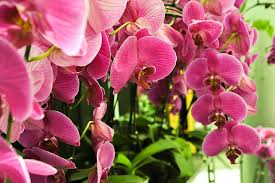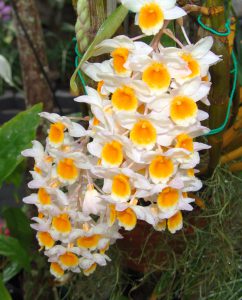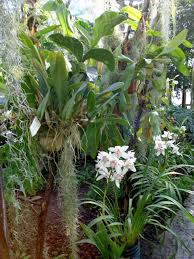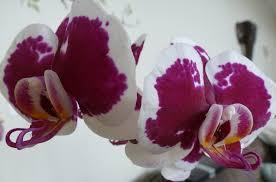How to Use Orchids in the Garden

There are many species of orchids that are beyond the scope of this article so we will be looking at some basic information about orchids, i.e. how to care for them and place them within the landscape. Orchids are in my opinion very exotic plants that can really add that elegant touch or flavor to our landscapes or interior plant scape.
I have worked with orchids over the years using them in many plant designs. I enjoy working with orchids because orchids can give that soft touch and appeal that can get the attention of just about anyone with their bright beautiful showy flowers.
Use of orchids in interior design
Many years ago I worked at a five- star hotel as an interior plant scape designer and had the privilege of working with many orchid varieties that included dendrobiums and phalaenopsis.
Adding these plants to arrangments with their many colors brought a delightful transformation to every space.
Photos of Dendrobiums

These are just a few of the many colors that you can add to your home/office to brighten up your surroundings. Dendrobiums can also be used on the exterior by attaching them to a trunk of a tree with a fishing line or some persons use nylon women’s hosiery.
Dendrobiums Growing on a tree
This is a unique way that orchids can be used to bring beauty and color into the landscape. It is so amazing that these plants can attach to the trunk of a tree with their roots and survive for a very long time.
Dendrobiums have the ability to draw moisture from the air. That is why orchids are known as ‘air plants’ being able to draw all the moisture that they need from the air.
How to train orchids to attach
Supplies you will need are:
- Fishing line.
- Spanish moss.
- 32oz spray bottle filled with water.
- Pruner or butter knife.
- Someone to assist.
- Ladder.
Care of Dendrobium indoors
Instead of soil, sphagnum moss is used to grow orchids. Make sure that the sphagnum moss is somewhat moist, not too wet, and not too dry. Mist the leaves as needed with water. From time to time also mist the sphagnum moss with water.
Phalaenopsis
Phalaenopsis orchids can also give that ‘wow’ to your landscape design. I have worked with these plants over the years and I have seen them in so many color varieties. In my opinion, Phalaenopsis gives a softer and elegant appeal.
Taking care of phalaenopsis is the same as taking care of dendrobiums. Phalaenopsis should also be handled with care because they can be damaged very easily.
Photos of Phalaenopsis
These are just a few of the many colors that you can choose from.
Mist the plant leaves enough so that plants can get the right amount of water. Orchids that are exposed to air conditioning do not need as much water because of the cold environment they are allowed to grow in. Make sure that your orchid plants get sufficient light. Like other plants, orchids also need some light. So placing them by a window or make sure the room they are in has the right amount of light is a necessity.
Pests and diseases control for orchid plants
As beautiful as our orchids are growing, it is always good to be on the lookout for insects and diseases that can cause orchids to drop their leaves and in some cases die.
Therefore it is good to have an inspection program where you inspect your plants at least twice a week, so if there is any problem you can take care of it before it becomes major.
Orchid plant pests
Some of these pests include scales, aphids, mealybugs, whiteflies, and spider mites. You can treat these plants by using insecticidal soap. Be sure and follow directions. With a spray bottle knock these insect pests off with a strong spray of water.
These insects will suck the juice from your orchid plants. The excrement from these insects is sugary and sticky which is called honeydew. This is followed by a black mold that forms on your plants due to this honeydew.
This black mold will not only cause your once beautiful plant to lose its beauty but if left unchecked your plant will eventually die.
To prevent this, use cotton swabs dipped in rubbing alcohol to be applied to the affected areas or apply neem oil.
Diseases affecting orchid plants
Disease issues are another thing we must deal with or try to avoid when caring for orchids. If you are faced with this challenge, there are measures you can put in place to combat this problem.
While discussing orchid plant disease is beyond the scope of this article because of its vastness, we will be looking at some of these measures in other articles that will teach you more in-depth.
Causes of orchid plant disease
Orchid plant diseases can be brought on by warm and moist conditions. Sometimes the aspiring gardener may use an infected tool on their plant without sterilizing it.
Diseases are caused by plant pathogens such as viruses, bacteria, and fungus. Therefore it is important that we do not create situations that are favorable to them.
When watering orchids do not overwater your plants. Try to always water your orchids during the day so it has time to dry out before nightfall. The sphagnum moss which the orchid grows should be somewhat moist and not waterlogged.
Make sure that the pot your orchid is growing in has good drainage because if your pot does not have proper drainage and your plant is allowed to sit in water, the leaves will turn yellow causing your orchid plant to experience leaf drop. So make sure that the pot which is being used has sufficient drainage holes.
Another way to avoid orchid plant disease is to make sure to provide good air circulation for your plant.
Orchid diseases consist of:
1. Bacterial leaf rot
2. Crown Rot
3. Bacterial root rot
Leaf rot causes the leaves to slightly discolor. If you allow this to persist the spot will become larger. The infected part will turn grey and then soft.
Remove the infected part of the leaf back to the sound tissue with a razor blade, sharp pruner, or scissors. Treat the sound part of the leaf with a bactericide
Crown rot: Crown rot attacks the uppermost leaves. The uppermost leaves become soft at the attachment point to the plant stem. Remove the uppermost leaves then treat the infected area with a bactericide.
Bacterial root rot: Bacterial root rot is caused by overwatering. When this occurs some of the lower leaves will show signs of shriveling, then the infected roots will become dark and soft. Treat the plant by cutting off the infected part of the roots and change the potting soil medium.
In the process of treatment, do not water your plant for a week and then water plant less than you did originally.
Leaf burn: Leaf burn happens when the plant is overexposed to sunlight.
Black spot: A black spot is caused by a lack of freshwater or too much fertilizer. Black spots will appear on the leaves so make sure that your plant gets good circulation.
Bud blast: Bud blast occurs either with the bud in the sheath, or when the orchids emerge as buds. This happens when you move your orchids from one environment to the next. Because of the change in temperature and lighting, the buds in the sheath develop bacterial rot. Sometimes the buds in the sheath turn black.
Due to the fact that moving your orchids from one place to the next can cause bud blast, wait until the flowering buds on your orchids open before moving them.
Follow these tips and you will have success with your orchid plants.
About the author
Norman loves being in the garden, both at home and for his job....
he is 'Natures Little helper' being outdoors, growing his vegetables and flowers from an early age.
Now having spent over 22 years in the profession he want to give some of his knowledge to others...
his vast array of hints and tips you will find scattered over this site will help you no end growing plants in your garden.



Plants are very vital to human needs, as majority of our necessities are derived from plants.
Thanks for your love and interest with plants, as i believe everyone has something to learn from each of your review and it is always a pleasure to read your reviews.
I’m glad i have been lucky enough to follow up with your various reviews and i look forward to more of your reviews
Thank you Mr. Johnson for those kind words they are very encouraging, sorry for responding so late to your email. And it is a pleasure sharing my reviews with you and with others. have a good day.
Thank you for your post on orchids. I have learned quite a number of things from it. One being, how to take of them. I agree with you that orchids are very exotic plants and that they can really add that special touch to the landscape. Which of the orchid species do you find most attractive? Thanks
Good day thanks for your kind remarks. sorry for taking so long to respond to your email. I love dendrobium and phalaenopsis, they are my favourite. Thanks again for the follow and have a good day.
Hello,
I really like this article! I have bookmarked it for future reference. At the moment we are not living in an area where outdoor orchids are a possibility but we plan on living in a climate where outdoor orchids are possible again in the future. We have lived in both Florida and Laos and both places we had orchids in the yard. My mother in law gave us some she raised in Florida and in Laos we got them from local vendors.
I am in a place where indoor orchids could be a possibility. I see that you have instructions for the care of Dendrobium indoors. So, these would be a good first coice for indoor orchids? Are they able to handle dry climates if you mist them?
In regard to the Pholaenopsis, do they do well indoors? Is the care of them indoors pretty much the same as the Dendrobium?
Are there other types of orchids you would recommend instead? We live in Albuquerque, NM so, it can be very dry much of the time.
Again, I really enjoyed this article.
Sincerely,
Xin
Hello Xin sorry for responding to your email a day after those kind remarks, dendroibums can take the dry weather as long as you mist them and yes the same care for dendroibums is basically the same as phalaenopsis. And these are just a few other orchids that you can try. cattleya, oncidium and vanda. Hope this helps and feel free to give me a shout if you ever need my help. Thanks again and have a good day.
These plants are really very exotic and exquisite. My dad owns a hotel which features an amazing collection of orchid plants. They really do add a nice touch to an already beautiful scenery.
This is a very informative article where you do mention a lot of things about orchids, and you use some words I have never heard before. Words like dendrobiums and phalaenopsis. I am currently doing my homework to learn what those are.
Hello Medu, and i agree with you orchids are very exotic and exquisite plants that can bring a whole different flavor. And i am glad to hear that you are doing your home work to find out more about what i call these wonders of nature, i am sure as you do your home work you will be amaze. Thanks again and please do tell others about my website. It is gardenofedengardencenter.com. Have a good day.